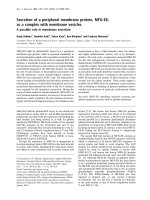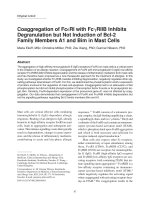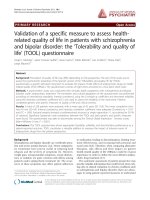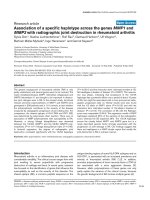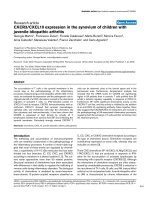Báo cáo y học: " Evolution of changes in the computed tomography scans of the brain of a patient with left middle cerebral artery infarction: a case report" pps
Bạn đang xem bản rút gọn của tài liệu. Xem và tải ngay bản đầy đủ của tài liệu tại đây (702.7 KB, 4 trang )
BioMed Central
Page 1 of 4
(page number not for citation purposes)
Journal of Medical Case Reports
Open Access
Case report
Evolution of changes in the computed tomography scans of the
brain of a patient with left middle cerebral artery infarction: a case
report
Kurien John*, Parag Singhal and Chris Cook
Address: Weston General Hospital, Weston-super-Mare, Somerset, BS23 4TQ, UK
Email: Kurien John* - ; Parag Singhal - ;
Chris Cook -
* Corresponding author
Abstract
Introduction: Stroke is a common and important condition in medicine. Effective early
management of acute stroke can reduce morbidity and mortality.
Case presentation: A 63-year-old man presented to the Accident and Emergency department
with a history of collapse and progressive right-sided weakness. Clinically this was a
cerebrovascular accident affecting the left hemisphere of the brain causing right hemiplegia.
Computed tomography scans, performed 3 days apart, showed the evolution of infarction in the
brain caused by the thrombus in the left middle cerebral artery. This is one of the early signs for
stroke seen on computed tomography imaging and it is called the hyperdense middle cerebral
artery sign.
Conclusion: Patients admitted with a stroke, undergo CT brain within 24 hours. The scan usually
takes place at admission into the hospital and is done to rule out a bleed or a space occupying lesion
within the brain. A normal CT brain does not confirm a stroke has not taken place. When scanned
early, the changes seen on the CT due to an infarction from a thrombus may not have taken place
yet. This paper highlights the early changes that can be seen on the CT brain following a stroke
caused by infarction due to a thrombus in the middle cerebral artery.
Introduction
Stroke is a common and important condition in medi-
cine. Effective early management of acute stroke can
reduce morbidity and mortality. It is predominantly a dis-
ease of people aged over 65 years but a significant number
will be younger. Brain imaging should be undertaken as
soon as possible, within 24 hours at most of onset. The
most common cause of stroke is cerebral infarction due to
a thrombus. Management of patients following a stroke is
complex.
Case presentation
A 63-year-old man presented to the Accident and Emer-
gency department with a history of mild frontal headache
and progressive right-sided weakness. He was on bend-
rofluazide and atenolol for hypertension which was con-
trolled.
On examination, he was fully conscious and haemody-
namically stable with a pulse of 65 beats per minute and
blood pressure of 105/72. Systemic examination was nor-
Published: 8 May 2008
Journal of Medical Case Reports 2008, 2:148 doi:10.1186/1752-1947-2-148
Received: 5 September 2007
Accepted: 8 May 2008
This article is available from: />© 2008 John et al; licensee BioMed Central Ltd.
This is an Open Access article distributed under the terms of the Creative Commons Attribution License ( />),
which permits unrestricted use, distribution, and reproduction in any medium, provided the original work is properly cited.
Journal of Medical Case Reports 2008, 2:148 />Page 2 of 4
(page number not for citation purposes)
mal. Power was 3/5 in the right arm and leg with the right
plantar reflex upgoing. There was progression of neuro-
logical signs 24 hours after admission, until the power
was 0/5 in the affected limbs with mild slurring of speech
72 hours later. There was no evidence of fluctuating neu-
rological signs. His higher mental functions were intact
throughout his hospital admission. The electrocardio-
gram confirmed sinus rhythm at 60 beats per minute. The
chest X-ray was unremarkable.
He was admitted and underwent an urgent computed
tomography (CT) scan of the brain. The initial CT (Figure
1) was performed 6 hours after the collapse. The hospital
had access to a magnetic resonance imaging (MRI) scan-
ner once a week and the next available slot was 6 days
later. During the weekend following admission he was
transferred to the stroke unit and reviewed twice daily. His
neurological deficits deteriorated stepwise with 2/5 power
in his right arm and leg at 36 hours progressing to 0/5
with mild slurring of speech around 72 hours post admis-
sion on Monday. There were no features suggestive of
raised intracranial pressure. He had no altered sensorium.
His case was discussed with the radiologist and the medi-
cal physician on call during the weekend. It was felt there
was no need for an urgent repeat scan and all agreed the
progression was likely to be due to the stroke. The radiol-
ogist reviewed the initial scan over the weekend and had
no concerns about the calcified area, which was judged
less likely to be a bleed, although this could not be ruled
out. The decision was to perform a scan on Monday morn-
ing to confirm that the deterioration was due to the stroke
and the suspected calcified area was not a bleed.
A repeat CT brain scan was performed after the weekend
on the third day after admission (Figure 2).
Discussion
CT scanning of the brain is invariably performed in the
evaluation of patients presenting with clinical signs of cer-
ebrovascular accident. The Royal College of Radiologists
guidelines now suggest that such scans should be per-
formed within the initial 24 hours of presentation. The CT
scanning of such patients is performed without the use of
intravenous contrast (unenhanced) thus avoiding poten-
tial confusion with subarachnoid haemorrhage. Below,
we summarise the findings and analysis of CT scanning of
the brain.
Normal brain and fundamentals of CT interpretation
The brain normal grey/white matter differentiation
should be examined, remembering that the fatty content
of the myelin-containing white matter appears to be of
lower density (darker) than the overlying grey matter. The
cerebrospinal fluid spaces are reviewed for symmetry and
it should be ensured that the midline remains central.
Areas of abnormal calcification (white) may be seen
within the choroid plexus and occasionally within the
basal ganglia.
Acute haemorrhage appears as an area of high density
(white). There is often surrounding low density oedema
with associated mass effect. Over the subsequent 7 to 10
days this high density changes in appearance to become
isodense with brain tissue and ultimately (after at least a
month) to appear as an area of low density.
Computed tomography scan of the brain 72 hours after admissionFigure 2
Computed tomography scan of the brain 72 hours after
admission.
Computed tomography scan of the brain at admissionFigure 1
Computed tomography scan of the brain at admission.
Journal of Medical Case Reports 2008, 2:148 />Page 3 of 4
(page number not for citation purposes)
In cases of infarction due to thrombus or embolism, the
area of infarct is seen as low density within the vascular
territory involved. However, an immediate CT brain scan
in acute middle cerebral artery (MCA) infarction may ini-
tially appear normal and the low density area may not be
apparent. Some early signs of acute MCA infarction are
loss of definition of the grey/white interface in the lateral
margins of the insula, leading to loss of insular ribbon [1],
attenuation of the lentiform nucleus [2], hemispherical
sulcus effacement and the hyperdense MCA sign
(HMCAS) [3]. The HMCAS is due to thrombus within this
vessel and indicates the likely development of an exten-
sive MCA infarction. There may be secondary oedema
causing mass effect in the acute phase of infarction. Simi-
larly, the normal grey/white matter differential pattern
may not be apparent because of cerebral anoxia causing
tissue oedema.
This patient's initial scan demonstrated high density
within the basal ganglia on the right side (not visible in
Figure 1 as the scan slice is few millimetres above this area,
but is seen in Figure 2). This is not in keeping with the
patient's clinical signs (right-sided weakness) and is too
dense to represent blood and shows no surrounding
oedema. It is therefore more typical of incidental calcifica-
tion within the basal ganglia. Close review of this scan
(Figure 1), however, does demonstrate increased density
within the left MCA. This is the HMCAS and suggests that
this patient is developing complete infarction of his left
MCA territory. These appearances are in keeping with the
patient's clinical presentation.
The second scan (Figure 2) confirms there is now exten-
sive low density throughout the left MCA territory. These
are the appearances of established complete infarction. As
expected, there has been no change to the probable long-
standing calcification within the right basal ganglia.
Final diagnosis
The appearances are those of extensive left MCA infarction
[4]. Although the first scan would initially appear to be
normal, high density due to thrombus is seen within the
left MCA [5]. The dense calcification within the basal gan-
glia on the right side is entirely incidental.
Conclusion
Aspirin was not commenced after the first scan due to the
remote possibility of a bleed (basal ganglia calcification).
An MRI scan was not available to confirm that this was not
a bleed. The gradual progression of the neurological signs
with no alteration in mental status were thought to be the
natural course of the stroke and therefore an urgent repeat
CT brain was not considered over the weekend.
He was treated with aspirin 300 mg for 2 weeks and there-
after continued on 75 mg [6]. Following 8 months of
physiotherapy and rehabilitation he had 5/5 power in all
four limbs and was able to carry out day-to-day activities
normally as before the stroke. According to the stroke
guidelines, aspirin and anti-platelet agents should be ini-
tiated as soon as haemorrhage is ruled out by confirma-
tory CT scan. It should be within 48 hours of the initial
event.
This case illustrates a very early sign of MCA stroke (infarc-
tion) on CT imaging, the HMCAS. It is important to
remember that there is usually a time lag before the signs
and symptoms are observed when the delivery of blood to
a portion of the brain fails, often due to partial or total
thrombosis of the blood vessel supplying that area. There
is an even greater time lag before definite CT scan changes
of an infarcted area of brain tissue may be seen. However,
changes such as loss of insular ribbon, obscuration of the
lentiform nucleus, hemispherical sulcus effacement, loss
of grey/white differentiation between the cortex and sub-
jacent white matter and HMCAS frequently present much
earlier.
Consideration for intravenous thrombolytic therapy (tis-
sue plasminogen activator, tPA) in stroke caused by inf-
arction is usually within 3 hours of the initial event but it
should be administered only in experienced, specialised
units with specific protocols in place [7]. The other
modalities of treatment in specialised units are intra-arte-
rial tPA, which can be administered up to 6 hours later,
and clot retraction with MERCI retriever.
In the not-so-distant future, on-call acute and general
medical physicians will be directly involved in adminis-
tering intravenous thrombolysis for early stroke due to
infarction and it is important to gain some knowledge
regarding various CT and other imaging changes that can
occur with acute stroke. Specialist stroke physicians, neu-
rologists and interventional radiologists will continue to
perform various invasive and interventional modalities of
treatment in acute stroke due to infarction.
Abbreviations
CT: computed tomography; HMCAS: hyperdense middle
cerebral artery sign; MCA: middle cerebral artery; MRI:
magnetic resonance imaging; tPA: tissue plasminogen
activator.
Competing interests
The authors declare that they have no competing interests.
Authors' contributions
KJ prepared the manuscript. PS was responsible for the
care of the patient. CC reported the computed tomogra-
Publish with BioMed Central and every
scientist can read your work free of charge
"BioMed Central will be the most significant development for
disseminating the results of biomedical research in our lifetime."
Sir Paul Nurse, Cancer Research UK
Your research papers will be:
available free of charge to the entire biomedical community
peer reviewed and published immediately upon acceptance
cited in PubMed and archived on PubMed Central
yours — you keep the copyright
Submit your manuscript here:
/>BioMedcentral
Journal of Medical Case Reports 2008, 2:148 />Page 4 of 4
(page number not for citation purposes)
phy scan. All authors read and approved the final manu-
script.
Consent
Written informed consent was obtained from the patient
for publication of this case report and accompanying
images. A copy of the written consent is available for
review by the Editor-in-Chief of this journal.
References
1. Truwit CL, Barkovich AJ, Gean-Marton A, Hibri N, Norman : Loss of
insular ribbon: Another early CT sign of acute middle cere-
bral artery infarction. Radiology 1990, 176:801-806.
2. Tomura N, Uemura K, Inugami A, Fujita H, Higano S, Shishido F:
Early CT findings in cerebral infarction: obscuration of the
lentiform nucleus. Radiology 1988, 168:463-467.
3. Schuierer G, Huk W: The unilateral hyperdense middle cere-
bral artery: an early CT sign of embolism or thrombosis.
Neuroradiology 1988, 30:120-122.
4. Petitti N: The hyperdense middle cerebral artery sign. Radiol-
ogy 1998, 208:687-688.
5. Koo CK, Teasdale E, Muir KW: What constitutes a true hyper
dense middle cerebral artery sign. Cerebrovasc Dis 2000,
10:419-423.
6. The International Stroke Trial Collaborative Group: A randomised
trial of aspirin, subcutaneous heparin, both or neither among
19,435 patients with acute ischemic stroke. Lancet 1997,
349:1569-1581.
7. Burger KM, Tuhrim S: Antithrombotic trials in acute ischemic
stroke: a selective review. Expert Opin Emerg Drugs 2004,
9:303-312.



